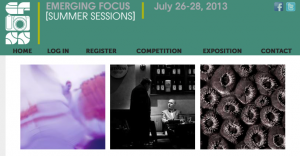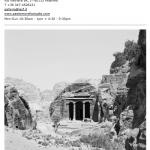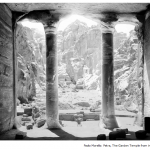junio 12, 2013
-
Emerging Focus: Summer sessions. 26 a 28 de julio de 2013
We are proud to announce the EMERGING FOCUS [SUMMER SESSIONS] July 26-28 2013, will be partnering with photo l.a. & Aesthesia Studios, Los Angeles. This three day event will showcase over 20 seminars on a range of photography topics from the business of photography, fine art and commercial photography, tips and techniques hands on training from leading experts through to photography tours throughout Los Angeles. In addition, amazing evening events, tours of local fine art photography galleries, and more!
Photo Nomad Tours offer a variety of ways to improve your photography skills with the guidance of internationally renowned photographers who have made their homes in these incredible LA neighborhoods. During these unique expeditions you’ll learn tips and techniques while exploring picturesque locations. All our photography programs are designed for professionals, and advance amateurs of all levels who are interested in improving their skills while exploring Los Angeles
http://www.emergingfocusexpo.com/
-
International ArtExpo: Liquid Borders, Bari, July 2013
Liquid Borders | Bari 2013
“La Corte – Fotografia e ricerca” cultural organization and International ArtExpo are proud to announce the opening of Liquid Borders – International art festival of photography, video art and installation, held in Bari (Italy) in the prestigious and historical locations of Castello Svevo (Swabian Castle), Santa Teresa dei Maschi and Sala Murat, from the 3rd to the 31st of July.
The press conference will be on Friday the 28th of June 2013 at 11.30 AM, in the Multimedia Hall of Castello Svevo (Swabian Castle).
The openings of the event will be on Wednesday the 3rd of July 2013 at Castello Svevo (Swabian Castle), at 06.00 PM; and on Thursday the 4th of July 2013 in Santa Teresa dei Maschi at 05.00 PM, and at Sala Murat at 06.00 PM.
The event will last until July 31st 2013.
The Festival is based on the main concept of the hybridization among art, culture, physical and social identities in contemporary cities, and the mixing between people and space. Urban environments, people, rules and limits are no more distinct realities, but they constantly modify and get mixed together, generating new connections and hybrid results, with undefined ethic, social, sexual and religious borders. Thirty-nine artists, from all over the world, have been invited to present their artworks related to the theme, during the festival which will be hosted in the three venues of the city of Bari, until the end of July. The aim of the festival is to understand which are the borders still alive in contemporary metropolis, and which ones have become undefined and hybrid. To understand that, artists use material, pictures, sounds, videos and site-specific installations. Fausta Maria Bolettieri and Luca Curci, curators.
In the Sala Sveva, at the ground floor of Castello Svevo, will be projected the video “Solipsist” by Andrew Thomas Huang, American filmmaker and artist, showcased at the Museum of Contemporary Art in Los Angeles (USA), the Saatchi & Saatchi New Directors Showcase at Cannes Lions (France), the Hammer Museum (USA), MOCA Taipei (Taiwan), the ZKM Media Museum in Karlsruhe (Germany) and the ASVOFF festival at Centre Pompidou in Paris (France). His short film “Solipsist“ was honoured at the Saatchi & Saatchi New Directors Showcase at Cannes Lions and won Best Experimental Short Film at the Slamdance Film Festival. The film caught the attention of Icelandic polymath Bjork, leading Andrew to direct her music video for “Mutual Core”, premiering at the Museum of Contemporary Art in Los Angeles (USA).
Furthermore the projection will include the video-architecture works “Ordos”, “Absolute Towers” and “Fish Tank” by MAD architects, founded in 2004 by Ma Yansong, the studio has been awarded the 2011 RIBA international fellowship. Among all the futuristic project realized by MAD architects: the Absolute Towers in Toronto (Canada), the China Wood Sculpture Museum (China), the Harbin Culture Island in Harbin (China) and the Ordos Museum (Inner Mongolia).http://www.lucacurci.com/artexpo/
International ArtExpo
Corso Vittorio Emanuele II, 33
70122 Bari (Italy)
+39.0805234018
+39.3387574098
internationalartexpo@gmail.com
www.lucacurci.com/artexpo -
Paolo Morello expone “Petra” en Scuderie di Palazzo Sambuca en Palermo
Petra in ancient Times
The oldest settlements in the area of Petra were inhabited by the Edomites – who were mentioned in the Book of Exodus – between the end of the VIII century and the beginning of the VII century BC. The town flourished a little later on thanks to the Nabataeans, an Arab nomadic tribe. In the first half of the II century BC the Nabataeans gave life to their kingdom, establishing in Petra their capital. Its ascent was mainly due to three different factors: the orography, which made it unconquerable, the abundance of water, and, most of all, the location. For several centuries Petra was the crossroads of the caravan routes from Aqaba and Yemen to Damascus and to Constantinople, which is to say, to all of the trade routes leading to a variety of goods – spices, incense, perfumes, and tar – from India to the Mediterranean countries and from Egypt to Persia.
The first king of the Nabataeans of whom we have recorded evidence was ‘Ubayda I (known also as Obodas I), who ruled from 96 BC to 85 BC. After his death, he was worshiped as a god, and the most sumptuous grave in Petra was very likely dedicated to him, the so called al-Deir (the Monastery). Around 80 BC, the Nabataeans conquered the Seleucid territories, extending their domain northward as far as the Euphrates river and Palmyra. The son of ‘Ubayda I, al-Harith III (Areta III), expanded their kingdom further, all the way to Damascus. The other famous grave in Petra, al-Khazneh (the Treasury), which owes its name to the mistaken belief that the treasure of an Egyptian Pharaoh was hidden in it, is most likely dedicated to al-Harith III. Al-Harith’s greatest success was the agreement he negotiated with the Romans: by paying a huge toll in silver, the Nabataean kingdom ensured its substantial independence. Petra grew in power and wealth from 9 BC to 40 AD under king al-Harith IV, when its population reached about 30,000 people. Toward the end of the I century AD, the Romans shifted their trade routes to Egypt and along the Nile river; new towns became pivotal along the caravan routes, such as Bosra and Palmyra in Syria. In 106 AD the Nabataean kingdom was peacefully taken over by Rome. Bosra became the new capital of the Roman province called Arabia Petræa and from then on, Petra’s slow decline began.
http://www.photography-now.com
http://www.paolomorellostudio.com/



